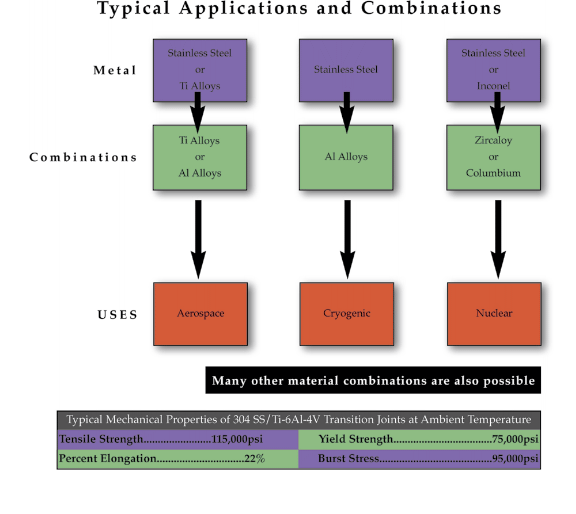![]()

Directory of Specialty Products
Transition Joints
Transition Joints are fabricated on a custom basis only, in that the material combinations, size and quality assurance testing requirements vary for each customer.
Starmet's transition joint extrusion process is readily adaptable to many metal combinations. Some of the more typical materials and their respective applications are listed below:
Beryllium TubingWhy Use Beryllium Tubing?
- Extremely light.
Density of Be (0.067 lb./in.3) is about two-thirds that of aluminum, plus its high strength permits much thinner wall tubing to be used as structural elements, further reducing weight. - Extreme Stiffness
Inherent stiffness of Be tubing, Young's Modulus of 42.106 psi, provides great rigidity and permits the use of lighter, thinner-walled tubing. - High Strength
Extruded Be tubing has a typical ultimate tensile strength of 100-120 K psi; and a yield strength of 60-75 K psi @ 0.2% offset. Elongation under stress is 5.5-7.5% in a 1" diameter tubing section. - Fully Wrought Seamless Tubing
Extruded Be tubing is a smooth, seamless, solid metal product that offers added assurance to mission life. It has no welds subject to failure, nor laminations that could possibly separate, when the structures encounter the extreme dynamic forces of space flight launch. - Low Coefficient of Thermal Expansion
Be has a low coefficient of thermal expansion (11.6 Micro-in./°C.), about half that of aluminum. Therefore, dimensional stability is maintained over the wide variations of temperature encountered in space applications. - Good Heat Sink Material
With a specific heat of 0.45 cal./g.°C., about double that of aluminum, Be provides a good heat sink for the protection of temperature-sensitive electronic components within a communications satellite.
Specific Applications
In addition to its utilization as structural components in communications satellites, Be tubing may be used as:
- Antenna booms in communications satellites.
- advanced inertial guidance systems components (using extruded Be rod and wire).
- Neutron moderator material or low neutron cross section components (in tube or rod form) in nuclear reactors.
- Structural supports for earth-based relay stations.
Sized Availability
Be tubing is available from 0.25" O.D. by 0.020 wall thickness to 4" O.D. by 0.250" wall, in lengths up to 15ft., depending on tube size. Tubing is extruded to sized producing a surface finish better than 125 RMS. Chemical etching can be performed if required.
Extrusion Services
Starmet Corporation is an acknowledged leader in the field of advanced extrusion technology, and in the development of metallurgical processes essential to the working of "new" materials such as high temperature superalloys, beryllium, titanium and advanced superconducting alloys. A further example of Starmet’s extrusion expertise was the development of the process to consolidate metal powders by extrusion. Starmet offers its expertise and vast experience to aid in the determination of optimum extrusion parameters for new metals and alloys undergoing research and development. Starmet can extrude, on a production or R&D basis, most metals within the size limitations of the equipment.
Extrusion Capabilities and Equipment
Extrusion presses at Starmet have maximum capacities of 100, 300, and 1400 tons. The table below outlines the specific capacities currently available.
| Extrusion Press |
Linear Diameter (in.) |
Billet OD (in.) |
Billet Max Length (in.) |
Press Max Force (tons) |
Max Furnace Temp |
| 100 Ton |
.900 1.100 |
.86 1.060 |
5 5 |
64 95 |
1900ºF |
| 300 Ton |
1.400 1.660 2.040 2.545 |
1.340 1.600 1.985 2.470 |
6 6 9 9 |
160 230 300 300 |
2200ºF |
| 1400 Ton |
3.050 3.545 4.050 4.555 5.060 5.565 6.070 6.575 7.080 |
2.950 3.470 3.925 4.430 4.935 5.440 5.945 6.425 6.930 |
12 12 17 19 17 17 17 18 17 |
790 1100 1350 1400 1400 1400 1400 1400 1400 |
2200ºF |








